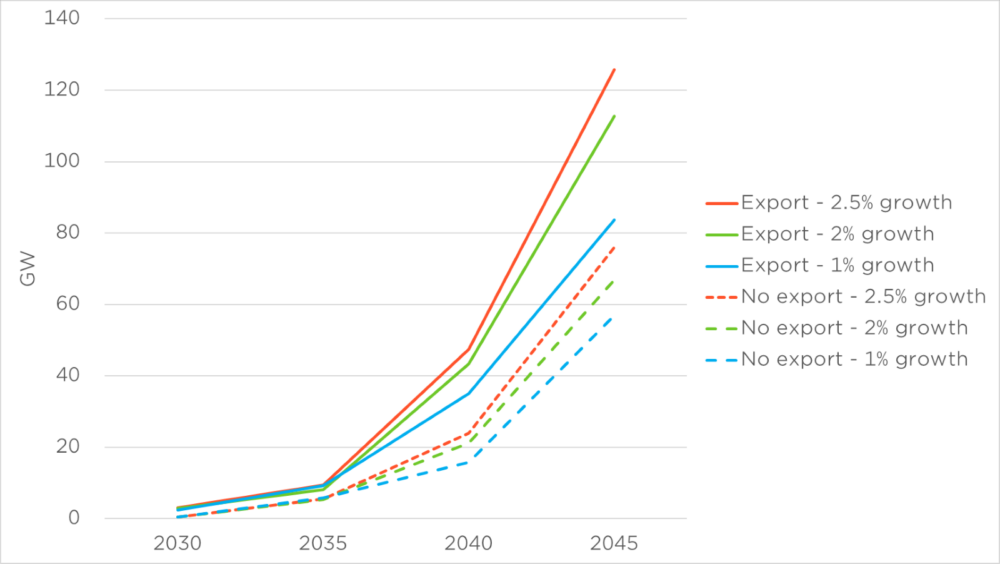Energy storage, or the storing of electricity for later use on the power grid, plays an important role in the clean energy transition. Many states have established targets or goals for deploying increased amounts of storage on the grid.
Illinois is currently considering policy proposals to establish a statewide energy storage target. To inform the amount of storage the state should seek, the Union of Concerned Scientists (UCS) conducted a modeling analysis of the Illinois power system to assess pathways to achieving state decarbonization and clean energy goals. Our project, Storing the Future: A Modeling Analysis of Illinois Storage Needs, evaluates different scenarios based on levels of annual demand growth and whether Illinois maintains its status as an energy exporter.
Why energy storage matters
The physics of our electric grid means that generation of electricity must match consumption in real time; all electricity produced must go somewhere, and there must be enough of it at all times to keep the lights on.
Renewable generation is variable—wind and solar power produce electricity when the wind is blowing and the sun is shining. We like it when their output matches up with when homes and businesses are using electricity, but that doesn’t always happen. Sometimes renewables produce too much electricity—meaning there isn’t enough demand on the system to use that energy—and sometimes they produce too little—meaning that other types of resources must be used to ensure there is enough juice on the grid to keep the lights on.
Traditionally, gas combustion turbines can play this balancing role, supplying energy when renewables under-produce. But they are costly, they pollute, and they don’t offer a solution for the excess energy produced by renewables. Relying solely on gas would thus result in “curtailment” of renewable output, or intentionally reducing the amount of electricity that a renewable facility is capable of producing based on the solar irradiance or wind speeds at the time. Curtailment means we are wasting otherwise clean, perfectly usable electricity.
Enter energy storage. Together with a robust, modern transmission system, energy storage can “smooth out” the generation profile of wind and solar, and ensure we ultimately use all those clean electrons by storing energy during times of over-production for reuse during times of under-production. Batteries—specifically, lithium-ion batteries with 4-hours of discharge capability—are the dominant form of energy storage today.
Adding energy storage to the grid provides numerous benefits for electricity consumers. In Illinois specifically, the Illinois Power Agency studied the benefits of energy storage deployment and found that it would increase electricity reliability, lower energy costs, reduce emissions, and generate positive economic effects. Other work commissioned by clean energy developers found substantial savings result from energy storage investment, including billions of dollars in consumer cost savings, increased grid reliability, and additional economic activity.
The Illinois energy landscape
Illinois passed the landmark Climate and Energy Jobs Act (CEJA) in September 2021. Among many other provisions, CEJA includes carbon emission limits for coal and fossil gas plants that phase in over several years, starting in 2030. CEJA also expanded incentives for wind and solar power; however, the law did not include significant provisions for energy storage deployment.
So now it’s time to think seriously about what amount of energy storage the state may need to complement renewable energy resources that are coming onto the grid to replace fossil fuel plants.
Setting a storage target is different than setting a renewables target (such as a renewable portfolio standard). We know that we need to keep building wind and solar as quickly as we can to replace the energy provided by fossil fuel plants as they are retired; however, the amount of storage we’ll need is tied to the grid conditions of the future and how fossil generation retirement interacts with the type and amount of renewables used to replace it.
So, UCS set out to examine this question of energy storage needs in Illinois. We also wanted to demonstrate the growing trend toward open-source modeling tools that rely on public data, rather than the expensive, proprietary, and closed models that are typically used in the energy industry.
Storing the Future
We created an open-source model of the Illinois electric grid using the Python for Power System Analysis (PyPSA) framework, a widely used and free platform for simulating and optimizing modern energy systems.
Our summary results, and full details of our methodology and assumptions, are available here.
We modeled the phase-out of Illinois coal and gas plants with six sensitivities. The first three maintain Illinois’ current status of generating more electricity than it needs (i.e., “exporting” electricity) and include different levels of load growth or increased electricity demand (1%, 2%, and 2.5% annual growth for low, expected, and high sensitivities). The next three sensitivities use the same load growth levels but assume that Illinois does not continue to export electricity.
Across all scenarios, we found that Illinois requires substantial energy storage development to meet long-term CEJA decarbonization goals. For instance, around 3,000 megawatts (3 gigawatts) of storage capacity is needed in 2030. From there, the needs rise sharply in 2035, especially if Illinois maintains its energy exporter status:
Illinois Near-Term Battery Capacity Needs (export scenarios)

This chart shows battery storage needs for Illinois in 2030 and 2035 depending on different load growth assumptions and assuming Illinois continues to export electricity at its current level. Source: UCS
The significant increase in 2035 is due to the phaseout of fossil fuels beginning in 2030; for 2035, less capacity is needed for 2% growth than for 1% because the rapid, early build-out of solar and wind to meet the higher growth slightly reduces storage needs later. Beyond 2035, modeled storage needs rise even further; however, the range varies greatly depending on the sensitivities:
Illinois Long-Term Battery Capacity Needs

After 2035, the cumulative effect of different load growth assumptions and whether Illinois remains an energy exporter produce wider ranges of storage needs and very large amounts after 2040 due to the large amount of renewables on the system and phased-out fossil units. Source: UCS
We don’t know what the future will bring. How much will electricity demand actually grow through data centers and factories, along with electrification of vehicles and buildings? Will other states build renewables so that Illinois does not need to keep exporting as much carbon-free electricity? Will new low-carbon resources like “advanced nuclear” enter the market?
Only time will tell. In the meantime, we need to give entities like the Illinois Power Agency the flexibility to continually assess the needs of the grid and the ability to set additional storage targets based on those needs.
Our recommendation is that Illinois set an initial deployment target of at least 3 gigawatts of energy storage by 2030. This is the equivalent of storing enough electricity to power at least half a million homes for 24 hours.
Our findings also support empowering the Illinois Power Agency to set additional storage targets based on assessment of the power grid and how things are going as we get closer to 2035, and beyond. But making a strong start with 3 gigawatts by 2030 is good, and also takes advantage of federal tax incentives under the Inflation Reduction Act that can lower costs for ratepayers.
Where do we need storage resources in Illinois?
So, if we have a general picture of how much battery storage Illinois might need, what about where to put it? Larger-scale energy storage installations can often be paired, or co-located, with wind and solar farms. This makes sense for batteries whose primary purpose is intended to absorb “extra” renewable generation as described above.
Prior UCS analysis has also shown that it’s helpful to locate storage in the general vicinity of fossil fuel plants that will be retired in the future. For example:
- Our 2018 report Soot to Solar included a case study looking at retiring the Waukegan coal plant in Illinois. We found that the existing Waukegan generation could be retired through installing 100 megawatts of new clean energy options, such as storage, at the site or somewhere in the many cities and towns surrounding downtown Chicago.
- UCS has also previously commissioned power flow modeling to study the effects of retiring Illinois fossil fuel plants connected to PJM, the regional grid operator serving the northern part of the state. This work demonstrated how adding new resources—such as solar, wind, and storage—in general areas of to-be-retired fossil fuel plants dramatically reduces the amount of expensive transmission upgrades that may be required to allow the plants to retire.
Finally, battery storage can benefit communities through local tax revenue and economic activity during construction. Accordingly, incentivizing the location of energy storage facilities in certain communities that desire to host them, such as communities that have lost jobs as coal plants shut down, can also be a positive step.
Battery storage policy is urgently needed
Utility-scale energy storage facilities, such as those with 100–200 megawatts of capacity, don’t just magically appear on the power grid—they take multiple years to plan and finance. Illinois needs policies in place now to jump-start development for our 2030 needs.
2025 is also a pivotal year for CEJA implementation in Illinois. The law requires state agencies to jointly study resource adequacy and the clean energy transition as the state moves closer to 2030 emission limits that will apply to several types of fossil fuel plants.
Additionally, several energy policy proposals are pending before the Illinois legislature, including programs to invest in battery storage deployment. The Illinois Clean Jobs Coalition, of which UCS is a member, has proposed the Clean and Reliable Grid Act and is also supporting enactment of battery storage programs alongside creation of an open-source, open data energy modeling capability within Illinois state agencies. Enacting as many of these policies as possible by early 2025 is important so that the agencies can include the anticipated effects in conducting the 2025 resource adequacy study discussed previously.
The state is also set to receive funding starting in 2025 under the federal Climate Pollution Reduction Grant program that Illinois can use for comprehensive energy system modeling. These funds can potentially be leveraged to invest in the creation of a long-term energy modeling capability in-house at a state agency.
As we look ahead, Illinois should use open-source, open data modeling similar to our approach in Storing the Future to continue assessing the state’s needs as it works toward the big CEJA goals: a decarbonized power sector and 100% renewable energy by 2050.

